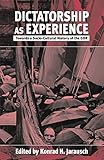Dictatorship as Experience : Towards a Socio-Cultural History of the GDR / ed. by Konrad H. Jarausch.
Material type: TextPublisher: New York ; Oxford : Berghahn Books, [1999]Copyright date: ©1999Description: 1 online resource (402 p.)Content type:
TextPublisher: New York ; Oxford : Berghahn Books, [1999]Copyright date: ©1999Description: 1 online resource (402 p.)Content type: - 9781571811820
- 9781782384793
- 943/.1087 23
- online - DeGruyter
| Item type | Current library | Call number | URL | Status | Notes | Barcode | |
|---|---|---|---|---|---|---|---|
 eBook
eBook
|
Biblioteca "Angelicum" Pont. Univ. S.Tommaso d'Aquino Nuvola online | online - DeGruyter (Browse shelf(Opens below)) | Online access | Not for loan (Accesso limitato) | Accesso per gli utenti autorizzati / Access for authorized users | (dgr)9781782384793 |
Frontmatter -- CONTENTS -- Preface -- List of Abbreviations -- Introduction -- Beyond Uniformity: The Challenge of Historicizing the GDR -- The Theoretical Problem of Dictatorship -- 1. The GDR: A Special Kind of Modern Dictatorship -- 2. Modernization and Modernization Blockages in GDR Society -- 3. Care and Coercion: The GDR as Welfare Dictatorship -- Mechanisms of Political Repression -- 4. From Dismantling to Currency Reform: External Origins of the Dictatorship, 1943–1948 -- 5. Foreign Influences on the Dictatorial Development of the GDR, 1949–1955 -- 6. Repression and Tolerance as Methods of Rule in Communist Societies -- Means of Social Control -- 7. Creating State Socialist Governance: The Case of the Deutsche Volkspolizei -- 8. Food Supply in a Planned Economy: SED Nutrition Policy between Crisis Response and Popular Needs -- 9. The Myth of Female Emancipation: Contradictions in Women’s Lives -- 10. The Socialist Glass Ceiling: Limits to Female Careers -- Cultural Dimensions of Domination -- 11. Dictatorship as Discourse: Cultural Perspectives on SED Legitimacy -- 12. The Fettered Media: Controlling Public Debate -- 13. Criticism and Censorship: Negotiating Cabaret Performance and Book Production -- 14. The Pivotal Cadres: Leadership Styles and Self-Images of GDR-Elites -- Temporal Transformations -- 15. Stagnation or Change? Transformations of the Workplace in the GDR -- 16. The Hitler Youth Generation in the GDR: Insecurities, Ambitions and Dilemmas -- 17. Reforming Socialism? The Changing of the Guard from Ulbricht to Honecker during the 1960s -- 18. Mobility and Blockage during the 1970s -- Postscript -- 19. Rethinking the Second German Dictatorship -- Selected Bibliography -- Notes on Contributors -- Index
restricted access online access with authorization star
http://purl.org/coar/access_right/c_16ec
A decade after the collapse of communism, this volume presents a historical reflection on the perplexing nature of the East German dictatorship. In contrast to most political rhetoric, it seeks to establish a middle ground between totalitarianism theory, stressing the repressive features of the SED-regime, and apologetics of the socialist experiment, emphasizing the normality of daily lives. The book transcends the polarization of public debate by stressing the tensions and contradictions within the East German system that combined both aspects by using dictatorial means to achieve its emancipatory aims. By analyzing a range of political, social, cultural, and chronological topics, the contributors sketch a differentiated picture of the GDR which emphasizes both its repressive and its welfare features. The sixteen original essays, especially written for this volume by historians from both east and west Germany, represent the cutting edge of current research and suggest new theoretical perspectives. They explore political, social, and cultural mechanisms of control as well as analyze their limits and discuss the mixture of dynamism and stagnation that was typical of the GDR.
Mode of access: Internet via World Wide Web.
In English.
Description based on online resource; title from PDF title page (publisher's Web site, viewed 25. Jun 2024)


